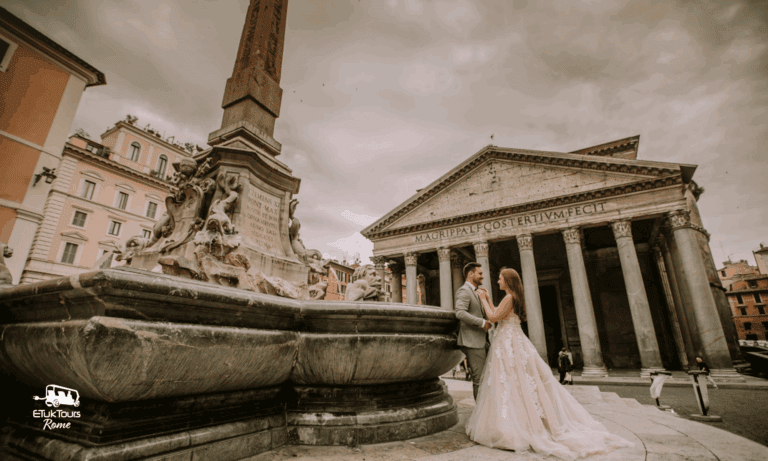Rome is a city that engages all the senses, but none more profoundly than taste. To walk its cobblestone streets is to be enveloped in the aromas of simmering sauces, baking bread, and freshly ground coffee. Yet, for the uninitiated, navigating the culinary landscape of Italy’s capital can be daunting. Tourist traps with picture menus abound, promising a taste of Rome but delivering a pale imitation. The true heart of Roman food beats not in elaborate presentations, but in a philosophy of powerful simplicity, where a few exceptional ingredients are transformed by time and tradition into something truly sublime. This guide is your key to unlocking that authenticity.
Unveiling Rome’s Culinary Heart: A Taste of True Authenticity
The Essence of Roman Cuisine
Roman cuisine is fundamentally a product of its environment and history. It is a rustic, assertive style of cooking born from the surrounding Lazio countryside’s pastoral traditions. Its core tenets are simplicity, seasonality, and an unwavering respect for high-quality ingredients. Unlike other regions in Italy, Roman food wasn’t heavily influenced by outside cultures; it was shaped from within. The city’s historic Jewish community, the oldest in Europe, contributed unique dishes and techniques, while the working-class Testaccio neighborhood, home to the continent’s largest slaughterhouse, gave rise to the “quinto quarto” or “fifth quarter” tradition—a nose-to-tail approach that masterfully utilizes offal and less-prized cuts of meat. The result is a food culture that is direct, flavorful, and deeply connected to its roots.
How This Guide Will Transform Your Roman Food Journey
This is more than just a list; it is a curated journey through the essential dishes that define the city’s culinary identity. We will delve into the iconic pastas, savory meat preparations, and unique vegetable dishes that locals cherish. You will learn not only what to eat but why these dishes are significant and what makes an authentic preparation stand out. Armed with this knowledge, you will be able to step away from the tourist thoroughfares and confidently find the trattorias and osterias where real Roman food is celebrated. Prepare to eat like a Roman and experience the city on a deeper, more delicious level.
The 10 Must-Try Roman Dishes: A Deep Dive into Authenticity
Carbonara: The Creamy, Peppery Masterpiece
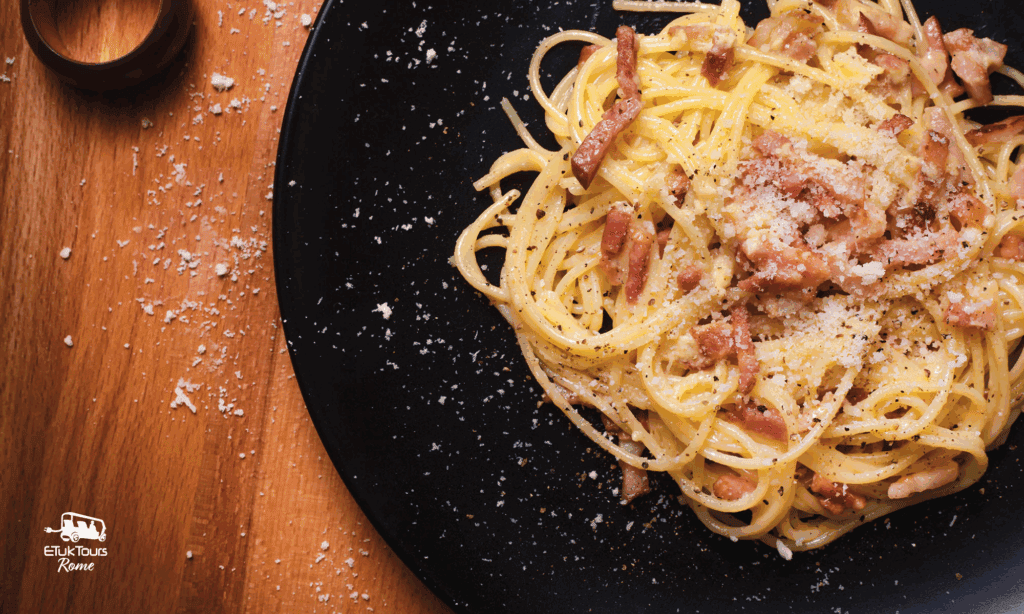
The magic of a true Roman Carbonara lies in its simplicity. The creamy sauce comes from an emulsion of egg yolk, pecorino, and pasta water—never cream.
Often imitated but rarely perfected outside of Rome, a true Carbonara is a revelation. This is not a dish made with cream. The magical, silky sauce is an emulsion of whisked raw eggs, copious amounts of sharp Pecorino Romano cheese, and starchy pasta water. The final key ingredients are crispy cubes of guanciale (cured pork cheek), whose rendered fat adds incredible depth, and a generous crackling of coarse black pepper. The origins are debated—some say it was a coal miner’s (carbonaro) meal, others that it was created for American soldiers after WWII—but its status as a Roman icon is undisputed. An authentic Carbonara is a masterclass in balance and technique.
Cacio e Pepe: Simplicity Defined
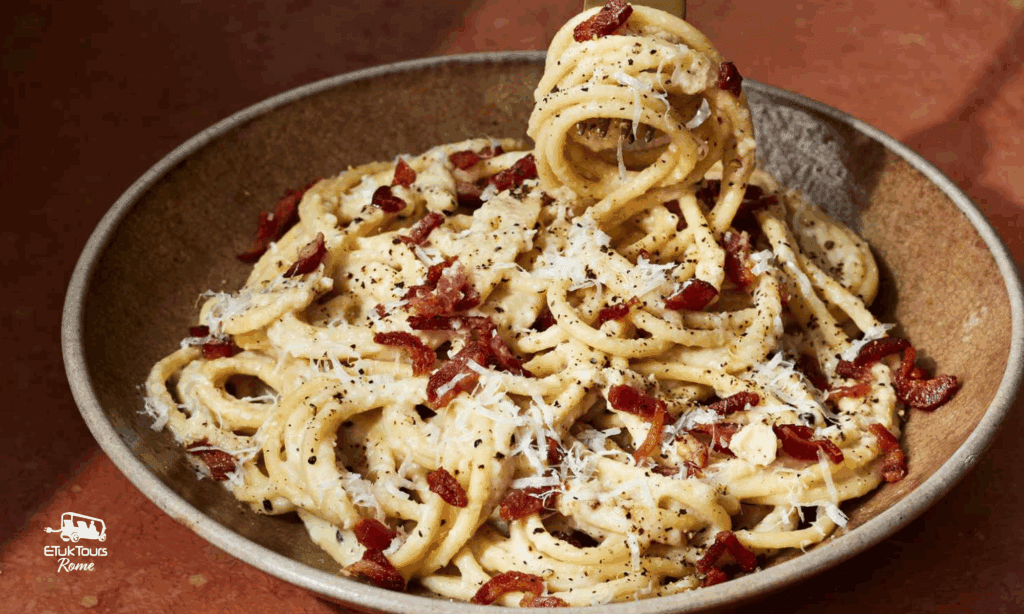
Cacio e Pepe, meaning “cheese and pepper,” is the ultimate expression of Roman culinary minimalism. With just three ingredients—pasta, Pecorino Romano cheese, and black pepper—this dish proves that complexity is not a prerequisite for perfection. The secret lies in the technique. The starchy, hot pasta water is meticulously whisked with the finely grated cheese and pepper to create a creamy, emulsified sauce that clings to every strand of spaghetti or tonnarelli. It is a deceptively simple dish that takes immense skill to execute correctly. When you taste a perfect Cacio e Pepe, you are tasting the soul of Roman cooking.
Amatriciana: The Robust Tomato and Guanciale Classic
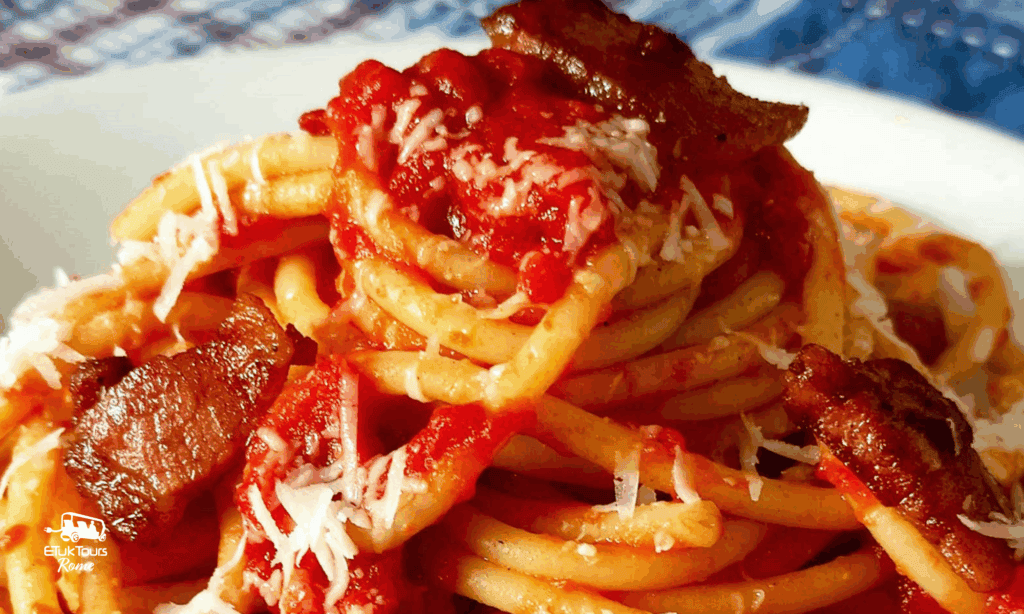
Named after the town of Amatrice, this dish has been wholeheartedly adopted by Rome. It represents the perfect marriage of guanciale, Pecorino, and tomatoes. The guanciale is rendered until crisp, its flavorful fat forming the base of the sauce. San Marzano tomatoes are then added, simmering into a rich, savory sauce that is punctuated by the saltiness of the pork and the sharpness of the Pecorino cheese grated on top. Traditionally served with bucatini, a thick, hollow spaghetti, Amatriciana is a hearty, deeply satisfying pasta dish that embodies the bold flavors of the region.
Gricia: The Ancestor of Amatriciana
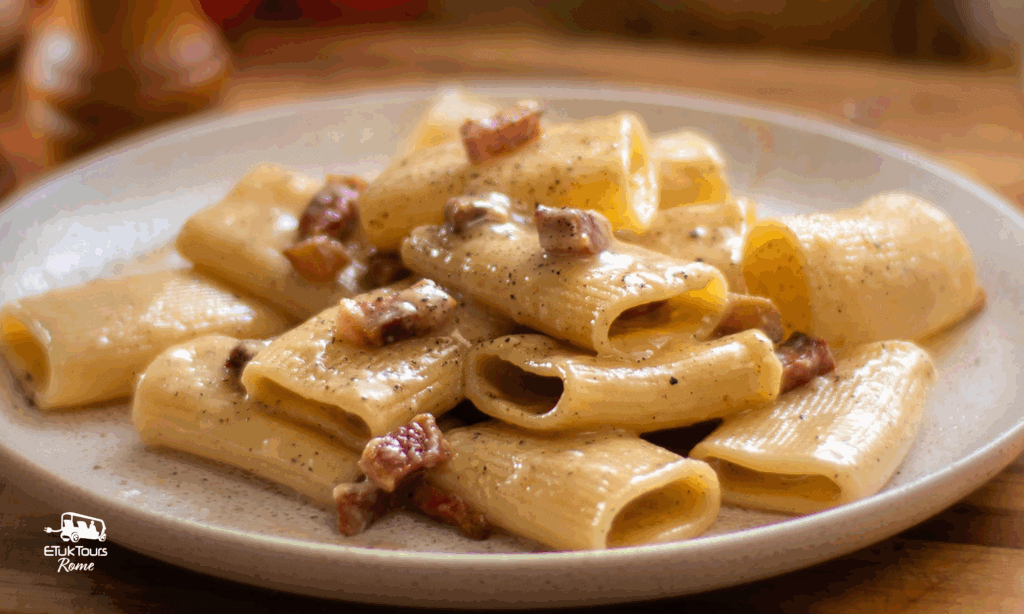
Often called “Amatriciana in bianco” (white Amatriciana), Gricia is the historical predecessor to its more famous, tomato-based descendant. It is essentially Carbonara without the eggs, or Amatriciana without the tomatoes. This dish showcases the holy trinity of Roman pastoral cooking: guanciale, Pecorino Romano, and black pepper. The preparation is straightforward: guanciale is fried to release its fat, which is then combined with pasta water and Pecorino to create a savory, pork-infused sauce. It is a powerful, rustic dish that allows the quality of its few ingredients to shine brightly.
Carciofi alla Giudia & Carciofi alla Romana: Rome’s Beloved Artichokes
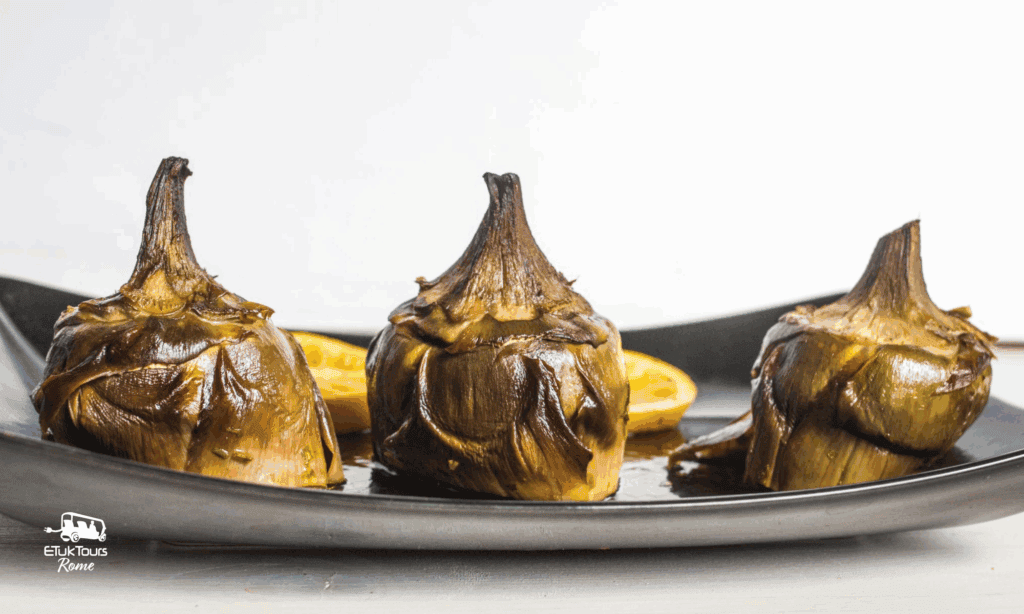
Rome’s love for artichokes is profound, best exemplified by two distinct preparations. Carciofi alla Giudia (Jewish-style artichokes) is a culinary treasure from the city’s ancient Jewish Ghetto. The artichoke is flattened and deep-fried whole until the outer leaves are shatteringly crisp like potato chips and the heart is tender and buttery. In contrast, Carciofi alla Romana (Roman-style artichokes) are gently braised with garlic, mint (mentuccia), and olive oil until they are melt-in-your-mouth soft. Trying both styles offers a delicious insight into the versatility of this celebrated vegetable.
Coda alla Vaccinara: The Quintessential Roman Oxtail Stew
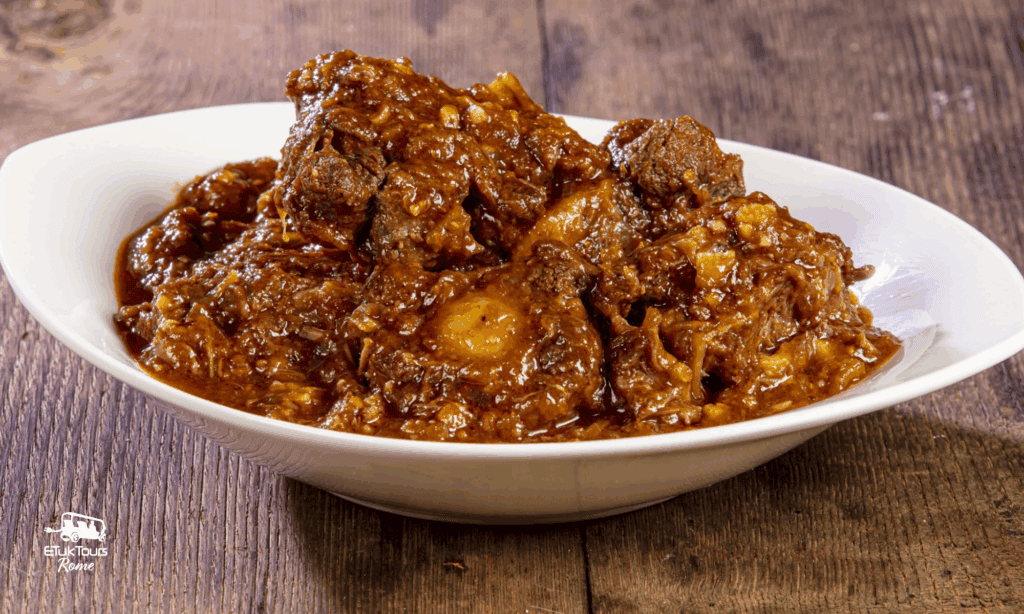
This is the crowning glory of “quinto quarto” cuisine. Coda alla Vaccinara is a rich, slow-braised oxtail stew that represents Roman cooking at its most patient and resourceful. The oxtail is simmered for hours—sometimes a full day—in a savory broth of tomatoes, celery, onions, and carrots. The meat becomes so tender it falls from the bone. Some traditional recipes include a unique bittersweet element from the addition of raisins, pine nuts, or even bitter chocolate, a testament to the dish’s complex flavor profile. It is a time-honored Roman food that transforms a humble cut of meat into a culinary masterpiece.
Supplì: Rome’s Irresistible Fried Rice Balls

Before you sit down for pasta, you might encounter Rome’s favorite street food: supplì. These are oblong croquettes of risotto rice, typically cooked with a simple tomato and meat ragù, with a piece of mozzarella tucked into the center. They are then breaded and deep-fried to golden perfection. The name supposedly comes from the word “surprise” in French, a reference to the moment you break one open and find the molten cheese stretching out, resembling a telephone cord—earning them the nickname supplì al telefono. They are a mandatory and delicious start to any casual meal in the city.
Saltimbocca alla Romana: A Quick & Flavorful Veal Dish

“Saltimbocca” translates to “jumps in the mouth,” a fitting name for a dish so packed with flavor it does just that. This classic secondo (main course) consists of thin escalopes of veal topped with a slice of salty prosciutto and a fresh sage leaf, all pinned together with a toothpick. The trio is quickly pan-fried in butter and white wine, creating a simple yet elegant pan sauce. It is a testament to the Roman ability to create an incredibly savory and satisfying meat dish in a matter of minutes.
Puntarelle alla Romana: The Bitter-Sweet Salad
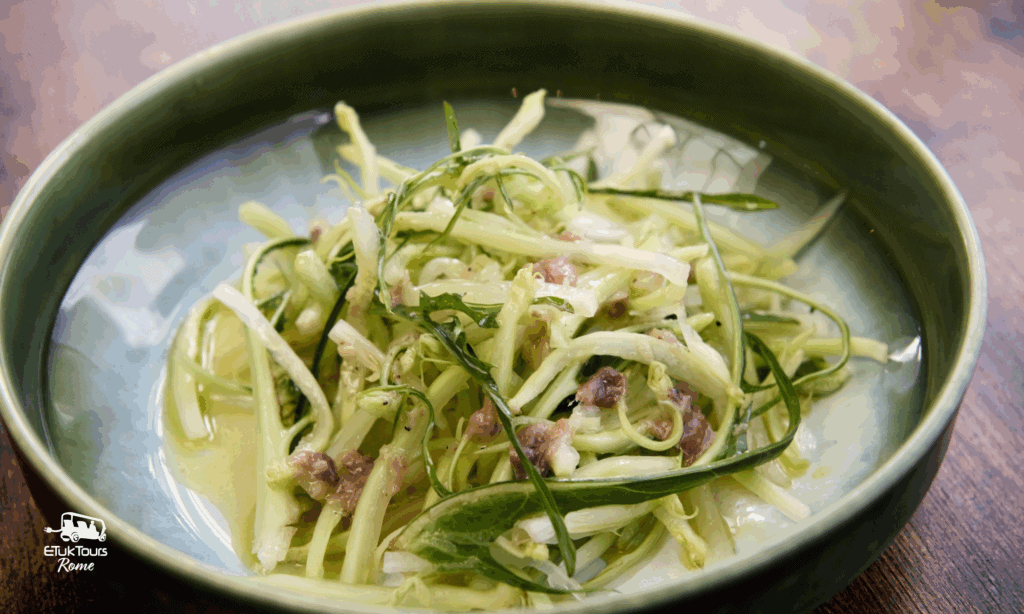
A true seasonal specialty, Puntarelle showcases the Roman appreciation for bitter greens. This dish is made from the tender inner shoots of a specific variety of chicory. The shoots are thinly sliced, then soaked in ice-cold water until they curl up and become crisp. They are then dressed in a powerful anchovy, garlic, vinegar, and olive oil vinaigrette. The combination of the crisp, bitter greens and the salty, pungent dressing is a uniquely Roman flavor experience and a refreshing counterpoint to the city’s richer dishes. You’ll typically find it on menus from winter to early spring.
Maritozzi con la Panna: Rome’s Sweetest Indulgence

For a taste of Roman breakfast or a sweet afternoon snack, look no further than the Maritozzo. This is a soft, sweet brioche-style bun, often enriched with raisins or candied orange peel, sliced open and filled to bursting with freshly whipped, unsweetened cream (panna). The bun itself is light and fragrant, providing the perfect vehicle for the decadent, cloud-like cream. It is a simple, indulgent, and utterly Roman pastry that has been enjoyed by locals for centuries.
Ready to taste Rome like a local? Join our Private Rome Food Tour by Italian TukTuk and experience these iconic dishes firsthand — fun, flavors, and hidden gems all in one unforgettable ride!
Your Expert Guide to Finding Authentic Eats in Rome
Distinguishing Between Eateries: Trattorias, Osterias, and Ristorantes
Understanding the local terminology is the first step to finding the right meal. A Ristorante is typically the most formal option, with a full menu, professional service, and higher prices. A Trattoria is a more casual, often family-run establishment serving traditional, home-style Roman food. The menu is usually smaller and based on what’s fresh. An Osteria was historically a simple tavern serving wine and a few basic dishes, but today the term is often used interchangeably with trattoria. For the most authentic experience, seek out trattorias and osterias away from the main tourist squares.
Spotting a Genuine Roman Restaurant
Authenticity often whispers rather than shouts. Look for places with a short, handwritten menu—a great sign that the dishes change based on seasonal ingredients. Listen for Italian being spoken by the patrons; if it’s filled with locals, you’re in the right place. Be wary of restaurants with hosts aggressively trying to lure you in from the street or those displaying glossy, faded photos of food. A truly great Roman eatery is confident in its cooking and doesn’t need gimmicks.
Ordering Like a Local: Navigating the Roman Meal
A traditional Italian meal is structured, but you are not obligated to order every course. The typical progression is Antipasto (starter, like supplì or bruschetta), Primo (first course, usually pasta, rice, or soup), Secondo (second course, a meat or fish dish), and Contorno (a side dish, like vegetables or salad, ordered separately). You can easily have a satisfying meal by ordering just an antipasto and a primo, or a primo and a secondo. Don’t be afraid to mix and match to your appetite.
Embracing Seasonal Eating
True Roman cuisine is deeply tied to the seasons. You won’t find fresh artichokes on a menu in August, nor will you see vibrant summer tomatoes in the depths of winter. Embracing this rhythm is key to an authentic experience. Ask “Cosa c’è di stagione?” (What is in season?). This question shows respect for the local food culture and ensures you will be eating ingredients at their absolute peak of flavor, just as any Roman would.
Essential Roman Dining Etiquette and Cultural Tips
Coffee and Gelato Culture
Coffee in Italy is a ritual. A cappuccino is strictly a morning drink; ordering one after a meal, especially dinner, will immediately mark you as a tourist. After 11 a.m., locals switch to espresso. When ordering gelato, look for gelaterias with natural, muted colors. Bright, puffy mounds of gelato often indicate artificial flavors and stabilizers. True artisanal gelato is dense, flat in its container, and made with real ingredients.
Language and Connection
While many Romans in the service industry speak English, learning a few basic Italian phrases will be greatly appreciated. A simple “Buongiorno” (Good morning), “Buonasera” (Good evening), “Grazie” (Thank you), and “Il conto, per favore” (The bill, please) goes a long way. It shows an effort to connect with the culture and will often be met with a warmer reception.
Savoring the Experience
Dining in Rome is not a race. Meals are meant to be savored over time, accompanied by conversation and perhaps a carafe of house wine. Don’t expect the bill to arrive until you ask for it. The table is yours for the evening. Relax, slow down, and enjoy the rhythm of Roman life. This appreciation for taking one’s time is as much a part of the food culture as the ingredients themselves.
Conclusion: Your Roman Culinary Adventure Awaits
Recap of Roman Flavors
From the deceptive simplicity of Cacio e Pepe to the slow-cooked complexity of Coda alla Vaccinara, the dishes of Rome tell a story of history, resourcefulness, and a profound respect for ingredients. You’ve journeyed through the four great pastas, celebrated the humble artichoke, and discovered the satisfying heartiness of the “quinto quarto.” This is a cuisine of bold, unapologetic flavors—the sharpness of Pecorino cheese, the savory depth of guanciale, and the perfect punch of black pepper.
Embrace the Journey
The true joy of eating in Rome lies in the discovery. Use this guide as your map, but don’t be afraid to wander off the marked path. Peek into a trattoria that looks inviting, try a dish you can’t pronounce, and engage with the people who are passionately preparing your food. The search for the perfect Carbonara or the crispiest supplì is part of the adventure.
Plan Your Next Culinary Expedition
Your journey into Roman food has just begun. On your next visit, or even on your next dinner out in the city, challenge yourself to try another dish from this list. Seek out the seasonal specialties like puntarelle, or start your day like a true Roman with a maritozzo. Every meal in Rome is an opportunity to connect with centuries of culinary tradition. Buon appetito







